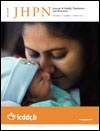Factors Influencing Childhood Immunization in Uganda
DOI:
https://doi.org/10.3329/jhpn.v31i1.14756Keywords:
BCG vaccine, DPT vaccine, Polio vaccine, Full immunization, Measles vaccine, UgandaAbstract
This paper investigates the factors associated with childhood immunization in Uganda. We used nationallyrepresentative data from Uganda Demographic and Health Survey (UDHS) of 2006. Both bivariate and multivariate approaches were employed in the analysis. The bivariate approach involved generating average percentages of children who were immunized, with analysis of pertinent background characteristics. The multivariate approach involved employing maximum likelihood probit technique and generating marginal effects to ascertain the probability of being immunized, given the same background characteristics. It revealed that slightly over 50% of children in Uganda were fully immunized. Additionally, 89%, 24%, 52%, and 64% received BCG, DPT, polio and measles vaccines respectively. Factors which have a significant association with childhood immunization are: maternal education (especially at post-secondary level), exposure to media, maternal healthcare utilization, maternal age, occupation type, immunization plan, and regional and local peculiarities. Children whose mothers had post-secondary education were twice as likely to be fully immunized compared to their counterparts whose mothers had only primary education (p<0.01). Thus, gender parity in education enhancement efforts is crucial. There is also a need to increase media penetration, maternal healthcare utilization, and to ensure parity across localities and regions.
J HEALTH POPUL NUTR 2013 Mar;31(1):118-129
Downloads
1694
1064

